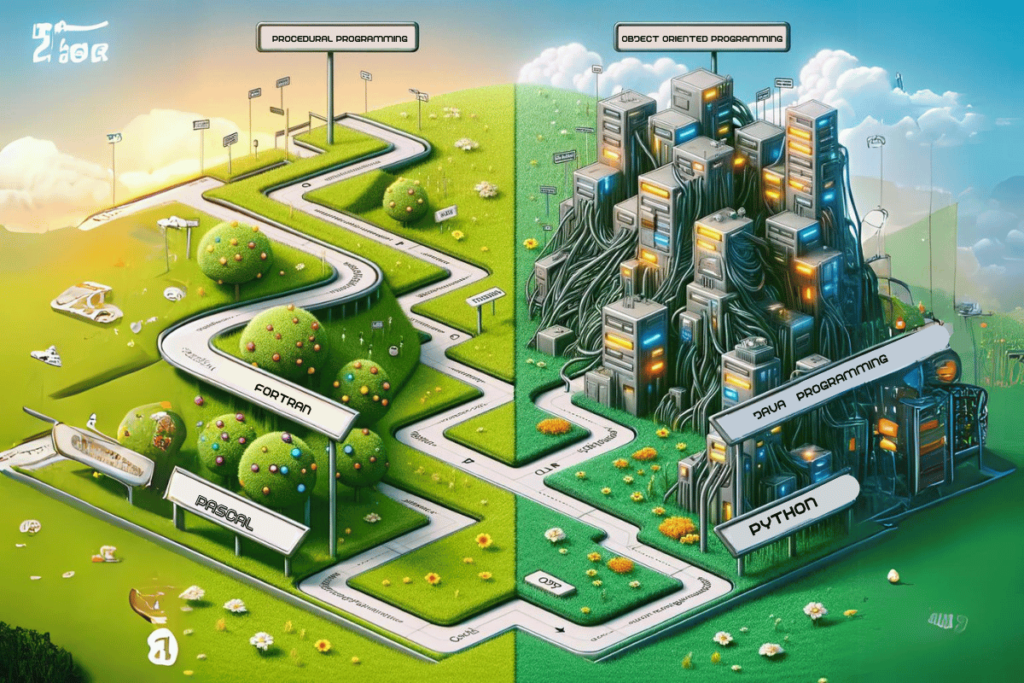Discover The Difference Between Procedural Programming and Object-Oriented Programming
Are you struggling to understand the key differences between Procedural and Object Oriented Programming? In this article, we will help unravel the complexities of these programming paradigms and guide you towards choosing the right approach for your coding needs. Stick around for some eye-opening insights!
Key Takeaways
- Oriented Programming (OOP) uses classes and objects to solve problems, making it great for big projects that need to be organized and easy to change.
- Procedural programming is about writing steps or procedures for the computer to follow. It works well for smaller projects with a clear sequence of actions.
- OOP can automatically pass state information with methods handling data, which differs from procedural where you manually pass state to functions. This makes OOP more streamlined.
- Popular languages like C++, Java, Python are used in OOP while C and Pascal are examples of procedural programming languages.
- When choosing between OOP and procedural programming, consider your project’s size, how easy it is to work in a team, and how complex the code will get as the project grows.
Definition of Object-Oriented Programming (OOP) and Procedural Programming
Procedural programming organizes code with procedures and functions, ideal for simple programs with linear flows.
Object-Oriented Programming (OOP) enhances code organization, reuse, and scalability, facilitating the management of complex systems. It’s best for projects needing flexibility, modularity, and extensibility.
Key Difference Between Procedural and Object Oriented Programming
Object-Oriented Programming (OOP) focuses on using objects to solve problems. It organizes software around data rather than functions and logic. This means in OOP, everything revolves around classes and objects, making it easier to track what’s happening with your data.
Did you know that in Object-Oriented Programming uses classes and objects help create models based on real-world environments?
Classes and objects are like blueprints and the things made from them.
- Classes: Are templates or blueprints that describe how something should be made.
- Objects: Are the actual things created based on those blueprints.
For example, if you have a class called “Car,” it would describe what a car is: it has wheels, doors, and an engine. An object created from this class would be a specific car, like a Toyota Camry or a Ford Mustang.
In simpler terms, classes define what something is, and objects are the actual things you can use or interact with based on those definitions.
Procedural programming, on the other hand, is all about writing a list of instructions for the computer to follow. It moves from top to bottom in a sequence of steps or procedures.
With OOP, you can automatically pass state information along with methods which handle that data. This stands out from procedural programming where state needs to be passed manually to functions.
Thus, OOP makes code more organized by bundling it into reusable pieces whereas procedural languages keep things linear and straightforward but might become challenging as projects grow larger due to its step-by-step nature.
What Will You Get From Reading The Rest Of This Article?
This article sheds light on the differences between procedural and object-oriented programming, offering insights that help college students make smarter choices for their coding projects.
By understanding each style’s advantages and disadvantages, readers learn how to select the best approach for different scenarios. This knowledge not only enhances critical thinking skills in software development but also empowers readers to tackle real-world problems more effectively.
Exploring procedural and object-oriented programming deepens comprehension of fundamental principles, making programmers more proficient and flexible. Practical examples provided here clarify how each paradigm works in actual applications, from simple routines to complex systems.
With this information, students can gear up for better performance in academic or personal projects, gaining a competitive edge in the tech field.
Understanding Procedural Programming

Procedural programming languages follow a linear, top-down approach to problem-solving. Dive into the world of procedural languages and discover their unique computational steps and sequence of instructions that drive the program’s functionality.
Characteristics and features of procedural languages
Procedural programming languages focus on a sequence of instructions. They use functions, local and global variables, and parameter passing to perform tasks. This style of programming follows a top-down approach, breaking down tasks into smaller procedures or functions.
It’s known for its simplicity and clear structure, making it easy for beginners to understand.
These languages don’t support classes or objects like object-oriented programming does. Instead, they thrive in environments where a step-by-step procedure is needed without modeling real-world objects.
Popular among procedural programming uses are tasks that require direct manipulation of data through computational steps.
Next up: Let’s explore Object-Oriented Programming and how it compares.
Examples of popular procedural languages
C, Pascal, and Fortran stand out as popular procedural languages. Each serves distinct purposes in the programming landscape. C excels in system programming due to its efficiency and control over low-level operations.
This makes it a fundamental tool for developing software that requires direct hardware interaction.
Pascal shines as an educational tool by offering a clear structure ideal for teaching basic programming concepts. Its simplicity encourages students to master structured programming techniques before diving into more complex languages.
On the other hand, Fortran holds a special place in scientific computing for its ability to handle mathematical computations effectively.
Understanding Object-Oriented Programming

Object-Oriented Programming (OOP) uses classes and objects for organizing code and data, encouraging reusability and modularity. Dive into the world of OOP for a deeper understanding.
Characteristics and features of OOP languages
OOP languages organize code around objects and data, promoting reusability and modularity. These languages enable the creation of flexible, scalable models representing real-world entities.
OOP emphasizes encapsulation, allowing for clearer code maintenance and reducing system complexity. Furthermore, it fosters easier collaboration among teams working on large-scale projects by providing a clear structure based on classes and objects.
JavaScript, C++, Java, and Python are prominent examples of OOP languages that underscore these principles in their design.
Examples of popular OOP languages
C#, Java, Perl, Python, Lisp, C++, JavaScript, and Lua are all popular OOP languages. They include features that make them well-suited for Object-Oriented Programming. Some common OOP languages widely used by developers include Java, C++, Python, Lisp, Perl, C#, JavaScript, and Lua.
Key Differences between OOP and Procedural Programming
OOP and procedural programming differ in problem-solving approaches, data handling, and code structure. These distinctions are important for choosing the right programming language for your projects.
Approach to problem-solving
Procedural programming follows a step-by-step approach to problem-solving. It focuses on breaking down tasks into smaller, ordered steps and solving them in sequence. On the other hand, Object-Oriented Programming (OOP) approaches problem-solving by focusing on real-life objects and their interactions.
OOP uses classes and objects as building blocks to solve problems, emphasizing the relationships between different components of a system rather than just the steps involved.
In procedural programming, emphasis is placed on a structured top-down method where solutions are derived from the code structure itself. In contrast, OOP emphasizes modeling real-life scenarios using objects and their interactions as the foundation for tackling challenges within a program’s logic flow.
Data handling and manipulation
Moving from problem-solving to data handling and manipulation, it’s essential to grasp how these programming paradigms approach working with data. In procedural programming, data and methods are distinct entities.
Functions operate on separate pieces of data to modify them. Conversely, in object-oriented programming, classes encapsulate both the data and the methods that act upon it. This means that in OOP, the relationship between data and its associated functions is more closely intertwined within objects.
Both programming styles handle and manipulate data differently – while procedural languages focus on procedures manipulating separate pieces of data, OOP ties together methods and related information within classes or objects.
Code structure and reusability
Object-oriented programming emphasizes the creation of reusable code through the use of classes and objects. This allows for easier maintenance and modification, as changes made to a class can affect all instances of that class.
On the other hand, procedural programming focuses on breaking down tasks into procedures or functions, which can also be reused throughout the program. However, the reusability may not be as seamless due to its reliance on global data.
Object-oriented programming’s approach to code structure enables better organization and encapsulation while promoting reusability through inheritance and polymorphism.
In object-oriented programming, code structure revolves around creating modular and reusable components in the form of objects. These objects are designed with built-in reusability features such as inheritance, allowing new classes to be based on existing ones.
Choosing the Right Programming Language

Consider the complexity and scalability of the language. Evaluate team collaboration dynamics and weigh the benefits and drawbacks of both styles.
Assessing complexity and scalability
Assessing complexity and scalability is important when choosing a programming language for a project. Here are some factors to consider:
- Consider the complexity of the project and how well the programming language can handle it.
- Look at the scalability of the language in terms of its ability to grow as the project expands.
- Assess the language’s support for managing large sets of data and processing complex algorithms.
- Evaluate how easily new features or updates can be integrated into the existing code base.
- Consider the language’s performance under heavy workloads and its ability to maintain efficiency.
These considerations are crucial when deciding which programming paradigm best suits your project needs.
Considering team collaboration
When working in a team, the choice of programming language significantly impacts how members collaborate on software development. Object-oriented programming allows for modeling real-world scenarios using classes and objects, which can enhance collaboration by providing a structured framework for tasks.
On the other hand, procedural programming may require more effort to coordinate among team members due to its linear approach. Given that the impact of choosing the right programming language is crucial for team collaboration, college students should carefully assess the implications it holds for their future projects.
Moreover, as teams delve into software development projects, they need to consider how their chosen programming paradigm affects code organization and reusability – key aspects that can either bolster or hinder collaborative efforts.
Benefits and drawbacks of both styles
Choosing the right programming approach involves understanding the benefits and drawbacks of both Object-Oriented Programming (OOP) and Procedural Programming. This comparison can guide college students in making informed decisions based on their project requirements.
Aspect |
Object-Oriented Programming |
Procedural Programming |
|---|---|---|
| Code Reuse and Maintenance | Facilitates code reuse and easier maintenance through encapsulation. | Can lead to code duplication and lacks modularity, making maintenance harder. |
| Understanding and Debugging | Potentially more complex, requiring a deeper understanding of concepts. | Simpler, linear structure enhances understandability and ease of debugging. |
| Data Handling | Efficient and organized code with classes and objects. | Less flexible in data manipulation, making changes harder over time. |
| Performance | May experience slower performance due to object management. | Generally offers faster execution times due to straightforward code execution. |
| Scalability | More suitable for large, scalable projects due to modularity. | Scaling up can be challenging due to lack of modularity. |
| Learning Curve | Higher learning curve due to complexity of OOP principles. | Easier for beginners to grasp and implement effectively. |
This comparison illustrates key considerations for students deciding between OOP and Procedural Programming. Each style has its unique advantages and challenges, making the choice dependent on the project’s specific needs and the team’s expertise.
FAQs
1. What is the main difference between object-oriented and procedural programming?
The main difference lies in how they organize code. Object-oriented programming groups data and functions together into objects, while procedural programming follows a series of steps or procedures to execute tasks.
2. Can you give examples of object-oriented programming languages?
Yes! Examples include Python, Java, and C++, which all support the creation and manipulation of objects.
3. What are some key features of object-oriented programming?
Key features include classes or objects, abstraction, and the ability to create high-level programs that can model real-world scenarios more effectively than procedural approaches.
4. Is procedural programming derived from any specific type of programming?
Yes, it’s derived from structural programming. It focuses on a sequence of actions or subroutines to perform tasks.
5. How does functional programming compare to these other programming paradigms?
Functional programming is another paradigm that treats computation as the evaluation of mathematical functions without changing state or data. It differs from both object-oriented and procedural by avoiding side effects and mutable data.
6. Why might a programmer choose one paradigm over another?
A programmer might choose based on the needs of their project; for example, if they need clear modeling of complex systems with lots of interactions, they might go for object-oriented. If their focus is on straightforward task execution with less concern about data structures or reuse across different parts of a program, procedural could be more fitting.
Conclusion
In understanding object-oriented vs. procedural programming, we unveil key differences impacting problem-solving and code structure. Assessing complexity and scalability can guide you in choosing the right programming language to navigate industry demands.
Object-oriented programming presents a new paradigm challenging tradition with its real-world models based on classes and objects, while procedural programming relies on separate data-operating procedures.
Consider these distinctions as you embark on your programming journey towards creating efficient and tailored systems for an ever-evolving technological realm.
If you liked this article, remember to subscribe to MiamiCloud.com. Connect. Learn. Innovate.






